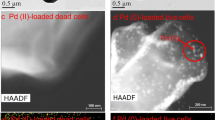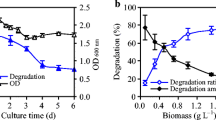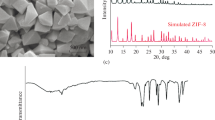Abstract
The viability of bacteria plays a critical role in the enhancement of fossil fuels biodesulfurization efficiency since cells are exposed to toxic compounds such as 2-hydroxybiphenyl (2-HBP), the end product of dibenzothiophene (DBT) biodesulfurization. The goal of this work was to study the influence of the carbon source on the resistance of Gordonia alkanivorans strain 1B to 2-HBP. The physiological response of this bacterium, pre-grown in glucose or fructose, to 2-HBP was evaluated using two approaches: a growth inhibition toxicity test and flow cytometry. The results obtained from the growth inhibition bioassays showed that the carbon source has an influence on the sensitivity of strain 1B growing cells to 2-HBP. The highest IC50 value was obtained for the assay using fructose as carbon source in both inoculum growth and test medium (IC50-48 h = 0.464 mM). Relatively to the evaluation of 2-HBP effect on the physiological state of resting cells by flow cytometry, the results showed that concentrations of 2-HBP >1 mM generated significant loss of cell viability. The higher the 2-HBP concentration, the higher the toxicity effect on cells and the faster the loss of cell viability. In overall, the flow cytometry results highlighted that strain 1B resting cells grown in glucose-SO4 or glucose-DBT are physiologically less resistant to 2-HBP than resting cells grown in fructose-SO4 or fructose-DBT, respectively.



Similar content being viewed by others
References
Srivastava, V. C. (2012). RSC Advances, 2, 759–783.
Gupta, N., Roychoudhury, P. K., & Deb, J. K. (2005). Applied Microbiology and Biotechnology, 66, 356–366.
Alves, L., Salgueiro, R., Rodrigues, C., Mesquita, E., Matos, J., & Gírio, F. M. (2005). Applied Biochemistry and Biotechnology, 120, 199–208.
Caro, A., Boltes, K., Letón, P., & García-Calvo, E. (2007). Biochemical Engineering Journal, 35, 191–197.
Gunam, I. B. W., Yamamura, K., Sujaya, I. N., Antara, N. S., Aryanta, W. R., Tanaka, M., et al. (2013). Journal of Microbiology and Biotechnology, 23, 473–482.
Chang, J. H., Chang, Y. K., Ryu, H. W., & Chang, H. N. (2000). FEMS Microbiology Letters, 182, 309–312.
Chen, H., Zhang, W. J., Cai, Y. B., Zhang, Y., & Li, W. (2008). Bioresource Technology, 99, 6928–6933.
Alves, L., & Paixão, S. M. (2011). Bioresource Technology, 102, 9162–9166.
Gregori, G., Citterio, S., Ghiani, A., Labra, M., Sgorbati, S., Brown, S., et al. (2001). Applied and Environmental Microbiology, 67, 4662–4670.
Hewitt, C. J., Bellara, S. R., Andreani, A., Nebe-von-Caron, G., & McFarlane, C. (2001). Biotechnology Letters, 23, 667–675.
Jacobsen, C. N., Rasmussen, J., & Jakobsen, M. (1997). Journal of Microbiological Methods, 28, 35–43.
Lopes da Silva, T., Roseiro, J. C., & Reis, A. (2012). Trends in Biotechnology, 30, 225–232.
Bouix, M., & Leveau, J. (2001). Journal of the Institute of Brewing, 107, 217–225.
Alves, L., & Paixão, S. M. (2014). New Biotechnology, 31, 73–79.
ISO 10712 (1995). Water quality—Pseudomonas putida growth inhibition test (Pseudomonas cell multiplication inhibition). Geneva: International Organization for Standardization.
Paixão, S. M., Teixeira, P. D., Silva, T. P., Teixeira, A. V., & Alves, L. (2013). New Biotechnology, 30, 598–606.
Alves, L., & Paixão, S. M. (2014). Applied Biochemistry and Biotechnology, 172, 3297–3305.
Borgne, S., & Quintero, R. (2003). Fuel Processing Technology, 81, 155–169.
Amor, K. B., Breeuwer, P., Verbaarschot, P., Rombouts, F. M., Akkermans, A. D. L., De Vos, W. M., et al. (2002). Applied and Environmental Microbiology, 68, 5209–5216.
Davey, H. M., Kaprelyants, A., Weichart, D., & Kell, D. B. (1999). Current protocols in cytometry (pp. 11.13.11–11.13.20). New York: Wiley.
Acknowledgments
The present work was financed by FEDER funds through POFC-COMPETE and by national funds through Fundação para a Ciência e a Tecnologia (FCT) in the scope of the project Carbon4Desulf—FCOMP-01-0124-FEDER-013932 (Ex–PTDC/AAC-AMB/112841/2009).
Author information
Authors and Affiliations
Corresponding authors
Rights and permissions
About this article
Cite this article
Teixeira, A.V., Paixão, S.M., da Silva, T.L. et al. Influence of the Carbon Source on Gordonia alkanivorans Strain 1B Resistance to 2-Hydroxybiphenyl Toxicity. Appl Biochem Biotechnol 173, 870–882 (2014). https://doi.org/10.1007/s12010-014-0902-6
Received:
Accepted:
Published:
Issue Date:
DOI: https://doi.org/10.1007/s12010-014-0902-6




